#Replacing the sensor array
Explore tagged Tumblr posts
Text
Samsung Watch Active Sensor Array Replacement
Duration: 45 minutes Steps: 7 Steps Ready to swap out a wonky or broken sensor array on your Samsung Galaxy Watch Active? This guide will walk you through the steps to get things back in working order. Let’s roll up our sleeves and get started! Step 1 – First, let’s get started by turning off your Galaxy Watch Active. Press and hold the bottom button for about 3 seconds – you’ll feel a quick…
0 notes
Text
Good News - August 15-21
Like these weekly compilations? Tip me at $kaybarr1735 or check out my new(ly repurposed) Patreon!
1. Smart hives and dancing robot bees could boost sustainable beekeeping

“[Researchers] developed a digital comb—a thin circuit board equipped with various sensors around which bees build their combs. Several of these in each hive can then transmit data to researchers, providing real-time monitoring. [… Digital comb] can [also] be activated to heat up certain parts of a beehive […] to keep the bees warm during the winter[…. N]ot only have [honeybee] colonies reacted positively, but swarm intelligence responds to the temperature changes by reducing the bees' own heat production, helping them save energy.”
2. Babirusa pigs born at London Zoo for first time

“Thanks to their gnarly tusks […] and hairless bodies, the pigs are often called "rat pigs" or "demon pigs” in their native Indonesia[….] “[The piglets] are already looking really strong and have so much energy - scampering around their home and chasing each other - it’s a joy to watch. They’re quite easy to tell apart thanks to their individual hair styles - one has a head of fuzzy red hair, while its sibling has a tuft of dark brown hair.””
3. 6,000 sheep will soon be grazing on 10,000 acres of Texas solar fields

“The animals are more efficient than lawn mowers, since they can get into the nooks and crannies under panel arrays[….] Mowing is also more likely to kick up rocks or other debris, damaging panels that then must be repaired, adding to costs. Agrivoltaics projects involving sheep have been shown to improve the quality of the soil, since their manure is a natural fertilizer. […] Using sheep instead of mowers also cuts down on fossil fuel use, while allowing native plants to mature and bloom.”
4. Florida is building the world's largest environmental restoration project

“Florida is embarking on an ambitious ecological restoration project in the Everglades: building a reservoir large enough to secure the state's water supply. […] As well as protecting the drinking water of South Floridians, the reservoir is also intended to dramatically reduce the algae-causing discharges that have previously shut down beaches and caused mass fish die-offs.”
5. The Right to Repair Movement Continues to Accelerate

“Consumers can now demand that manufacturers repair products [including mobile phones….] The liability period for product defects is extended by 12 months after repair, incentivising repairs over replacements. [… M]anufacturers may need to redesign products for easier disassembly, repair, and durability. This could include adopting modular designs, standardizing parts, and developing diagnostic tools for assessing the health of a particular product. In the long run, this could ultimately bring down both manufacturing and repair costs.”
6. Federal Judge Rules Trans Teen Can Play Soccer Just In Time For Her To Attend First Practice

“Today, standing in front of a courtroom, attorneys for Parker Tirrell and Iris Turmelle, two transgender girls, won an emergency temporary restraining order allowing Tirrell to continue playing soccer with her friends. […] Tirrell joined her soccer team last year and received full support from her teammates, who, according to the filing, are her biggest source of emotional support and acceptance.”
7. Pilot study uses recycled glass to grow plants for salsa ingredients

“"We're trying to reduce landfill waste at the same time as growing edible vegetables," says Andrea Quezada, a chemistry graduate student[….] Early results suggest that the plants grown in recyclable glass have faster growth rates and retain more water compared to those grown in 100% traditional soil. [… T]he pots that included any amount of recyclable glass [also] didn't have any fungal growth.”
8. Feds announce funding push for ropeless fishing gear that spares rare whales

“Federal fishing managers are promoting the use of ropeless gear in the lobster and crab fishing industries because of the plight of North Atlantic right whales. […] Lobster fishing is typically performed with traps on the ocean bottom that are connected to the surface via a vertical line. In ropeless fishing methods, fishermen use systems such an inflatable lift bag that brings the trap to the surface.”
9. Solar farms can benefit nature and boost biodiversity. Here’s how

“[… M]anaging solar farms as wildflower meadows can benefit bumblebee foraging and nesting, while larger solar farms can increase pollinator densities in surrounding landscapes[….] Solar farms have been found to boost the diversity and abundance of certain plants, invertebrates and birds, compared to that on farmland, if solar panels are integrated with vegetation, even in urban areas.”
10. National Wildlife Federation Forms Tribal Advisory Council to Guide Conservation Initiatives, Partnerships

“The council will provide expertise and consultation related to respecting Indigenous Knowledges; wildlife and natural resources; Indian law and policy; Free, Prior and Informed Consent[… as well as] help ensure the Federation’s actions honor and respect the experiences and sovereignty of Indigenous partners.”
August 8-14 news here | (all credit for images and written material can be found at the source linked; I don’t claim credit for anything but curating.)
#hopepunk#good news#honeybee#bees#technology#beekeeping#piglet#london#zoo#sheep#solar panels#solar energy#solar power#solar#florida#everglades#water#right to repair#planned obsolescence#trans rights#trans#soccer#football#recycling#plants#gardening#fishing#whales#indigenous#wildlife
137 notes
·
View notes
Text
Singularities
A lone ship stands vigil over the void, a small freighter who's cargo has been replaced with scientific equipment and weaponry. It sits comfortably far from a black hole, it's observation deck filled with subalterns and sensor arrays, taking in the glory of the vast [ nothing/everything ] in front of it. Most would say this ship was a ghost ship, their sensors coming up dead from the looks of things. For a moment, it seems to creep towards the Accretion Disc, before automated systems push it back to safety. A single word echo's through the ship. "Beautiful."
21 notes
·
View notes
Text
Hound Dogs
“… tomorrow we’ll meet your handler. For now, rest up.”
RDAI.vii.1156 stared down at its new body. Joining the military was considered the best route a Class-F citizen could pursue - free food, shelter, maybe even a few augments if you got lucky. But the Rapid Deployment Auxiliary Infantry unit felt less lucky and more confused. It signed up expecting to be given a gun and a pat on the back, not… this.
The arms were probably the strangest change. Skilled military surgeons had removed its forearms with a single blast of a laser that numbed its pain and severed flesh and bone at the same time. In their place, 1156 now wielded on each arm a single long, spider-like metal blade that extended all the way to the floor. The same happened to its legs, forcing the unit onto all fours. A reinforced spine kept it from collapsing onto the ground.
The rest of its body was covered in angular metal plates, designed to redirect and resist gunfire and protect the unit’s remaining flesh. Its face was likewise covered by an solid steel visor, vision and hearing substituted by an array of cameras, sonar, and radio scanners that fed information directly into its augmented brain. Its mouth remained uncovered but its teeth were removed and replaced with a new carbon fiber set. The chip in its brain repressed its discomfort so it didn’t try to claw off its own jaw.
A buzzer sounded and a tray carrying a bowl of nutrimeal slid out of the wall of the room. Unit 1156 stared it at, trying to figure out what to do - an injected concoction of hormones and suppressants had kept it comfortably dull, but somewhat muddled.
>EAT
The word flashed up on the inside of its visor, glaring into its semi-redundant eyes - eyes now dedicated to receiving screen-fed orders. It obediently craned its head down and started chomping at the slop. It was starving - the accelerated healing process was effective but it sapped all the solider’s energy.
Even if its senses hadn’t been muted, the nutritional goop was flavorless. Nevertheless it found itself slurping away with abandon, licking the bowl clean, dignity cast aside. Its faceplate glowed white hot for a moment before cooling down again, singeing off specks of food that had flown astray in the unit’s feeding frenzy. This feature was meant to burn blood and dirt off so that it didn’t impair an RDAI’s sensor array, but it worked for dinner well enough.
>GOOD MUTT
*****
The next day found RDAI.vii.1156 waiting in the main hangar, still slightly trembling on its spindly new legs. The thin, bladed design was perfect for chasing down enemy troops on the battlefield or pinning a straggler to the ground, but it was difficult to balance with even with the aid of the unit’s brain augments. A cord plugged into the back of its head kept it from wandering too far while feeding low-level electrical pulses that helped calm its nerves. It was waiting for its new handler - the soldier it would fight alongside, whose life it would dedicate itself to protecting. The bond between a handler and their hound (as the units were fondly referred to) was something truly unique, and though 1156 hadn’t planned to end up on this side of the relationship, it couldn’t help but feel excited.
It could feel her presence long before she actually entered the hangar. Perhaps it was merely the hormonal braindeck releasing waves of dopamine, but to the cyborg’s mind she was the most perfect being in the world. It could almost taste the draw of her augments to its own, pulling the two of them together like magnets. It knew that she felt it too. The connection between them was already established: the handler and the hunter, the owner and the dog.
It couldn’t quite remember what beauty looked like but it decided that she must be as close as one could get. Bent on all fours as 1156 was, it stood about half a meter shorter than her. Encased in a shiny automorphic techsuit, her body rippled with hidden energy ready to be unleashed at a moment’s notice. Her one eye shone, the other replaced by an implant that flashed rapidly as if to say, it’s finally you.
A technician standing by unplugged the unit’s tether and stuck in a thinner, double-ended wire. 1156 trembled as its handler grabbed the other end and slowly slotted it into a port on her neck.
The instant the plug connected, 1156 nearly collapsed from the tsunami of pleasure that struck it at full force. All Handler’s emotions, all her thoughts, her very essence flowed through its brain, and it could tell that she was experiencing the same influx of data.
They stood there for what seemed like forever, its faceplate lights flashing in sync with her vitals node. The only sound was the slight clinking of metal on concrete as 1156 shifted from talon to talon. Her designation was RDI-H.2054, she was a Class-E civilian who was recruited at age 8, she had been trained as a handler for 11 years, but 1156 was her first hound of her own. She liked the color green, she hated morning training, she had been deployed overseas on a scouting mission just three months ago. The unit’s brain felt overloaded with information and yet more kept flowing in.
It saw vague images, faces of people that it didn’t recognize yet felt so familiar - Handler’s family? It saw the fire of war, the smiles of fellow soldiers, it felt her heartbeat, her brainwaves, her every breath. For a split second, the hound and the handler were not separate but rather a single entity, one soldier in two bodies, sharing their memories. 1156 felt its Handler’s cybernetic eye and her prosthetic leg, and she likewise felt its spindly new form and armor plating.
RDAI.vii.1156 felt 2054 about to scream and roared out in sync. Its twisted metallic vocal chords, designed specifically to instill fear in the enemy, pierced the air in the hangar with an unearthly screech which neither overwhelmed nor surrendered to its keeper’s voice but rather merged with it in a feral harmony.
*****
Blood spewed down the dog’s chin and through crevasses in its armor. It spit out a chunk of flesh with strands of muscle tangled in its reinforced teeth. As it stepped back from its prey, its pointed blades withdrew from within the dead footsoldier’s chest. The unit’s faceplate sizzled, burning away blood and viscera and turning its vision bright red for a moment. It let out a fierce howl, launching itself forwards with a speed unmatched by any two-legged infantry.
Just behind it, its handler finished off a tank pilot attempting to crawl away from its craft. The hound’s many sensors highlighted the remaining stragglers on the battlefield, and 2054 assessed the remaining threats as she ran. She spotted a wounded soldier training their scope onto her companion and raised her weapon, disintegrating the enemy’s face with a single clean blast. The hound bayed its gratitude before finishing its run, speeding between rocks and debris and eliminating the last few soldiers.
One, two, three, blood gushed from their chests as 1156 pounced on them, puncturing their lungs and tearing out their throats in quick succession. RDI-H.2054 watched and basked in the adrenaline - her brain had not been upgraded to manage her auxiliary’s entire suite of sensors, but they shared many core sensations. They both felt the rush of war, the warmth of blood on their faces, and most of all an immense wave of satisfaction and even euphoria. Nothing felt better than killing together - an entire battalion laid to waste at their hands gave them a jolt of dopamine that felt better than orgasm.
They were never awarded for their feats, nor did they feel the need for any such recognition. Deep in their programming they didn’t fight for any cause or nation, or even for their commanding officer. They fought merely to tear and bite alongside each other, to see the fear in their enemies’ eyes and feel their life drain out at the will of the hound of death and its handler.
Standing together in the remains of a decimated army, they surveyed their work. The air smelled of blood and the familiar scent of plasma-scorched air. 1156 playfully rammed its armored face into its handler’s chestplate, grunting and drooling red down her torso. She laughed and rubbed the top of its head, sending microscopic ripples of pleasure down its spine.
>GOOD JOB DARLING
215 notes
·
View notes
Note
Hello, this is callsign Scrappy reporting with Kid and Khopesh. Hello. We require your expertise, wizard. Yeah, what Khopesh said. We kind of uh.. assumed you're the local "Weirdness expert" based off what we've seen on the omninet, and after this whole "NHP-controlled ship loaded with greywash attacks us" we've been having some.. small issues. Now, for clarification, we pilot a Chomolungma with a plentiful dose of goblin licensing. Long story. But uh.. Well, you see. Due to some.. extensive experimentation with our ability to influence machinery, I was outfitted with a subjectivity enhancement suite. I see the sensor-scape better that way and my... hold over all sorts of systems improved since then. But it has come to my attention that there's.. nubs on my hardsuit. I've been in it for way too long during that whole mess, so that might have something to do with it. We do not believe it should be doing that. We have not altered the hardsuit in any meaningful way. We believe we've somehow managed to pass on goblin code to the hardsuit, contaminating it. We would like Your opinion, machinist.
[Below is an attached image of a stealth hardsuit- and indeed, it has slight nubs present on its arms, back and back of the head.]
>>OH HI!!!!! Hi it's cool people know me!!!! I think I can definitely help with this :3 I'm not too up on chassis engineering but I've been making due since people only really bring me chassis nowadays.
>>As far as I can tell, Goblin liturgicode is actually pretty heavily contagious and tends to infect hardsuits that come into contact with it!!! The development of those kinds of nubs on the plating is actually the beginnings of a Goblin's sensor array, the kind of spikes or antennae that you usually see on frames in the PG. This is kinda what happened to my hardsuit!!! The circumstances around mine was way different, though.
>>So!!!! It seems like you're a Goblin pilot now :3 congratulations!!!! As of now, the Goblin should still function as a hardsuit if you want to keep your Chomolungma, but as the sensor array starts growing in properly it'll develop its own systems that won't play nice with other computers. Then, you'll have both a fully formed Goblin and a Chomolungma!!! You can print a new hardsuit once that happens and keep piloting as normal, but be aware that the liturgicode will probably keep infecting any hardsuit you use in the Chomolungma and you'll need continuous replacements.
11 notes
·
View notes
Text
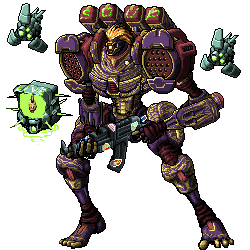
This here is my own pride and joy! Best known as
COGITO ERGO BOOM
I think, therefore you explode.
This beauty here is my very own custom Monarch Chassis, courtesy of the Smith Shimano Corporation. This thing fields some of the most advanced guidance systems this side of the Long Rim PLUS the explosive ordnance to back it up. Despite its size and relative capacity for destruction, it's actually pretty quick. Being able to rapidly reposition, see over most other mechs and cover, field a wide array of high range weapons, and hack its opponents with its powerful on board computers and sensors, the Monarch makes for an excellent all-arounder run and gun mech. It's most impressive qualities are it's independently targeting Avenger Silos and its COMP/CON assisted seeking payload, a system that fires a missile at a target you can see only when it can absolutely guarantee the strike will be successful and an advanced computing algorithm that allows the Monarch to bypass all cover, armoring and resistances that it's enemies may have.
Now my Cogito is really something special. I've fitted her with some auxiliary concussion missiles of my own design, as well as a custom Smith Shimano ferrofluid paint job. She's also fitted with a good old GMS personal shield which comes in real handy (especially since the power draw starts pushing my reactor a bit which helps to fuel some other "dangerous" and "irresponsibly radioactive" personal modifications I've made to the Cogito).
As far as weapons she's fielding, We're packing a standard GMS Assault Rifle, because even with all the guided missiles in the system, sometimes all you need is a good old fashioned hail of bullets.
The next weapon is some total piece of shit I mounted before realizing that it didn't even work. Some rare piece of equipment some schmuck on the Icebreaker sold me, called it a "Verbal Gun" or something. I hooked it up with an SSC Stabilizer Mod and everything and when I took it down to the firing range to try it out, the damn thing wouldn't go off! Still looks pretty cool and had a decent camera built into the thing so I scrapped the original Monarch receptors and replaced it with that seeing as it was SSC compatible. Doesn't do anything too crazy but ever since I installed it every so often I'll get a pop up of a little guy on my hud when one of my squad mates takes a hit saying he's hungry and a button pops up to feed him some pellets. We'll whenever I press that pellet button the ferrofluid on my mech freaks the hell out and sorta... bites???? A chunk out of whoever just hit my teammate??? I've tried reaching out about it to my SSC contact but the messages never go through for some reason. Regardless, I'm gonna keep feeding him his "snicker-snacks", not just gonna let the poor little guy starve.
And last but not least. The Gandiva Missiles. Self guided rockets that lock onto anything with a computer and don't stop til they've given them a proper knock on the door if you know what I mean. I can hit anything with these bad boys, with or without my eyes closed. Each rocket is wirelessly in contact with the firing platform which is constantly sending and receiving combat data to a COMP/CON Hivemind out in the Core Worlds. In fact, I've gotten a couple messages from my sponsor contacts about some issues they've been having at the hivemind headquarters about some of their COMP/CON units getting infected with some kind of weird virus and that they suspect it may have something to do with my Gandivas in Calliope and their proximity to our unique dialect of COMP/CON (Shout out to my loyal camera man, Keith). Regardless of vocal quirks, this weapon is top of the line SSC firepower that I've been lucky enough to level at a number of Long Rim baddies.
Stay tuned for next time, where I'll be going over one of the other mechs piloted by Hell's Gate's finest.
Stay Frosty Brothbros! And remember! YOU ONLY NEED ONE ☝️😉!
#lemme know what i should call these#smith shimano corpro#jerry's angels#in golden flame#lancer rpg#lancer#lancer rp#sprite by my friend logan.
16 notes
·
View notes
Text
A Tyrant, Chained
Dr. Selestri Zlovol surveyed the cave opening, spreading her mouth in a thin smile. She had found the blank slate upon which to craft her magnum opus. A dragon was an obvious choice, but those of Jund were a cut above. They were apex predators, more often dying of old age or other dragons than another species. And the way they died! Old age was somewhat inaccurate, as the eldest of these hellkites often plunged themselves into a volcano, instinctual completion of primal ritual that restored their mana to the ecosystem of Jund! She was going to enjoy altering this one. That the lair would then be used by the Hayashis to begin mining sangrite and other precious minerals was of less interest to her, but their desire to have a presence in this brutal land would mean that her creations would see use, and she would have a chance to collect more specimens. Maybe she would see if any of the local “sentient” organisms actually possessed any intelligence.
While a condition of her wanting to take this dragon alive was her presence on the mission, she would not be doing the heavy lifting. That was better left to beings more suited for it, and she had brought ten of them with her. Kamigawan ogres, were a perfect base to make into engines of labor and war. Yes, perfecting the methods of instilling obedience into them was… difficult, but rewarding. Sure, many of the ogres who were the initial round of test subjects went a little berserk, but that was four years ago. And maybe some of the enforcers the Hayashis hadn’t bought out were looking into the incidents, but burning down the slum where they had taken the subjects from and dumped the failures in was a clean way to have the investigation closed. Determining causes of death was a lot harder when the corpses had been reduced to ash.
The best results of that program stood with her now, KO-63, KO-89, KO-124, KO-137, KO-156, KO-185, KO-198, KO-200, KO-202, and KO-211. Their eyes had been replaced with visual sensor arrays, shoring up one of their primary weaknesses, and beneath their helmets, the primary modification shored up the other. In addition to quelling their more unpredictable tendencies, the neural implants also increased their ability to process information, and act quickly without relying on brute instinct. Aside from some minor tinkering, these ten were almost identical in terms of modifications, but varied a bit in height. Each was armed with a harpoon tranquilizer cannon, able to both pierce a creature’s flesh and reel it to the ground. Two carried a muzzle, and all carried extra lengths of chain to bind the beast.
Dr. Zlovol carried an electric coil pistol she had modified from an old Izzet design on of their frivolous artificers had discarded and her field repair kit, but was otherwise unarmed. Well, except for her clawed metal arm. She wasn’t planning on getting directly involved though, so it was of little consequence. With a mental command, she sent the KOs (Kamigawan Ogres) in.
She heard the roar of a dragon, the clank of chains, the thump of flesh on flesh, and the crunch of metal. Within a few minutes, nine of the ogres dragged the dragon, wings bound to the scaly torso, from the cave. The last, its armor battered, approached Dr. Zlovol. “Doctor, there is a development that requires your input to handle.” it said, voice monotone.
“Explain. Show me where if you cannot.” Dr. Zlovol responded.
“Eggs. Should they be collected or disposed of?”
“Eggs?” Dr. Zlovol shouted, expressing more emotion than she had in two years. Quickly recomposing herself, she responded. “Collected, carefully. Not by you. I’ll take one myself, and have a more… dexterous team collect the rest.”
“Understood.” The KO marched back over to the chained dragon, and picked up the tail, to make sure that it did not get caught in the thick underbrush of the jungle.
Dr. Zlovol hurried into the cave, ignoring the bloodstains and bones littering the floor. There, in the back, laying in a nest of branches padded with sticks and leaves, were four dragon eggs. Each one was bigger than Zlovol’s head, but still able to be carried by the doctor, albeit with both hands. Of those hands, each flesh and bone finger shook with excitement, but the metal one’s internal gyroscopes stabilized it against the tremors.
Hours later, on Kamigawa, a dragon shrieked in agony, despair, and most of all, rage. Needles stabbed into her brain, forceps pulled her limbs apart, and chemicals coursed through her bloodstream. Her pain was immeasurable, cutting through the lingering haze of the sedatives, but some of her anguish was because she had been separated from her eggs. Jundian dragons fiercely guarded their eggs from aggressive competitors, scavenging viashino, and cruel humans, but they did tend to guard the eggs more zealously than the live young. Even though clutches were rarely laid, baby dragons eating baby dragons wasn’t uncommon, and adults eating the babies was just as common. In at least one instance, a particularly aggressive juvenile, on the cusp of being kicked out of the nest, had attacked their mother and managed to kill them with a lucky strike to the head. Life as a Jundian dragon wasn’t easy, and the mothers made sure that at least the time in the eggs was safe. Dr. Zlovol didn’t know any of this, but she would learn.
She was more focused on the modifications, and most of all, the eggs. Although she was happier than she’d been in decades, some doubt was starting to seep in. The dragon had been given enough tranquilizers to kill three Avishkari bull elephants, and had woken up during the initial examination, thrashing about, sending soratami, robots, and equipment flying, until some KO’s managed to restrain her and Dr. Zlovol injected the dragon with a different sedative, hoping that by mixing the drugs, the effect would compound. It did, but the dragon was still awake, if sluggish and no longer causing active damage. She was watching her automatons vivisect and begin to experiment with control implants on the subject, now designated JD-1, which was so far, not responding well to any of the transmitted commands. It was a beast of a specimen, 13.23 meters from tip to tail, with a 24.71 meter wingspan, and weighing in at 11.05 kilotons. A quick analysis of telomeric decay estimated JD-1’s age as somewhere between 110 and 120 interplanar standard years, and scales had been removed to record material composition of the natural armor. A scraping of the claws and teeth had been taken for similar study, but the most interesting thing of JD-1’s biology was its blood. It was hot inside the body, and when removed for chemical analysis, a spilled drop had caused ignition on contact with dry paper. Post-assessment had determined that this wasn’t due to anything related to the chemical or temperate properties of the blood, but rather because of the red mana coursing through the fluid. The potential was immeasurable.
The other, possibly larger discovery, the eggs, were in an incubator, tuned to replicate the climate of a Jundian volcanic cave, being analyzed by some of her soratami assistants. In Dr. Zlovol’s eyes, that was what soratami were best at, lab analysis. While she would be the first to admit that vedalken like herself were not paragons of physical strength and stamina, they were more… resilient than the fragile moonfolk. The most useful part of a soratami was their brain, not their body, so the majority of sentient subjects she had successfully improved from Kamigawa were KG’s (goblins), Kch’s (orochi), KH’s (humans), KN’s (nezumi), and KO’s (ogres), rather than KS’s (soratami). But, they were good at tabulating and interpreting data, and that is what Dr. Zlovol was using them for. So far, the age of the eggs was estimated at a few months, but until hatching, that would likely be unknown, unless Dr. Zlovol’s orders were overridden and an egg was dissected to learn more. Unfortunately, she still reported to a handful of soratami, and even worse, the doddering humans who funded them. Although, she mused silently, she couldn’t be all mad at the Hayashis, as it was their desire for etherium and other valuable resources that had led to the expedition to Jund. House Hayashi wanted to extract as much sangrite as possible from the region to have the nation of Esper at their mercy, with a monopoly over the necessary component of etherium, which was used in all parts of Esper technology, including their augmentations which had allowed for their vedalken to endure for centuries. The other minerals and ores that would be extracted by the mining operation were merely a side benefit. The ability to trade sangrite for etherium was what the Hayashis were primarily concerned with. Once obtained, it would be Dr. Zlovol’s job to build them new bodies, using an etherium base, supplemented with cloned flesh, and having their minds and souls uploaded into the shells. Dr. Zlovol was more than happy to agree to this. If the Hayashis were inside forms of her creation, they would be under her control. But, that was a long-term plan. For now, there were the eggs, and subject JD-1.
In an underground facility, just outside the city of Towashi, near the foothills of the Sokenzan mountains, a dragon howled in rage. She did not know that she was now called subject JD-1, and she did not care. This world would burn, and she would start the fire.
#planar posting#alara posting#jund posting#mtg rp#kamigawa posting#vorthos#dr. zlovol#dragon broodmother
6 notes
·
View notes
Text
Cancelled Missions: Gemini Saturn V
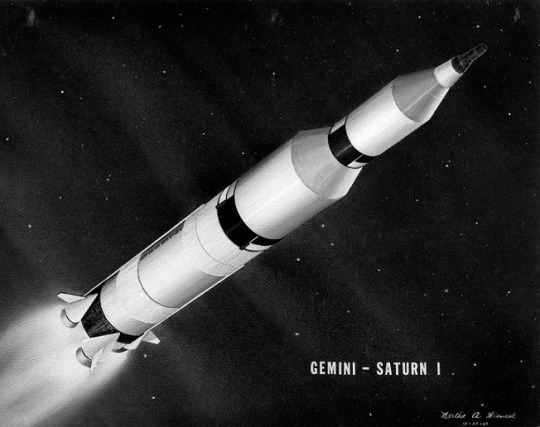
-Concept Art, however this has a typo, as this is clearly the Saturn V.
"American manned lunar orbiter. In l LP late 1964 McDonnell, in addition to a Saturn IB-boosted circumlunar Gemini, McDonnell proposed a lunar-orbit version of Gemini to comprehensively scout the Apollo landing zones prior to the first Apollo missions.
Status: Design 1964. Gross mass: 11,182 kg (24,652 lb).
The lunar orbit version required an Agena stage to provide the delta-V for lunar orbit insertion and trans earth injection. The 1.52 m-diameter Agena was enclosed in an inverted conical fairing to both transmit thrust loads to the Gemini and provide thermal protection during the coast to the moon.
Alternatively, a propulsion module based on a repackaged Apollo Service Module propulsion system, as had been proposed two years earlier for a lunar-landing version of Gemini, could be used. This raised the translunar injection mass of the spacecraft to 11,182 kg, well above the capability of a Saturn IB or Titan III-C, but only a quarter that of a Saturn V. The launch vehicle was unspecified, but could only have been a Saturn V used on an early test mission. The mission profile would have involved a 68 hour flight from low earth orbit to lunar orbit, a 24 hour lunar mapping mission in a 10 nm x 80 nm lunar orbit, and a 68 hour return flight. The scientific equipment would consist of a modest camera array installed in the nose of the spacecraft. This consisted of a long focal-length telescope, to which were attached two narrow-field stereo mapping cameras, a wide field mapping camera, a panoramic camera, and two 16 mm film cameras. The film was not accessible by the astronauts, being stored in a film vault shielded against radiation in the nose of the spacecraft. The camera compartment would protrude from the stub nose of the Gemini after parachute deployment.
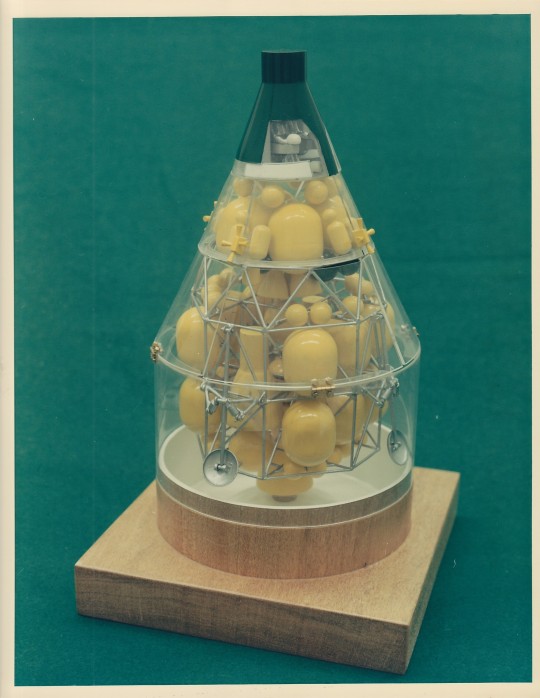
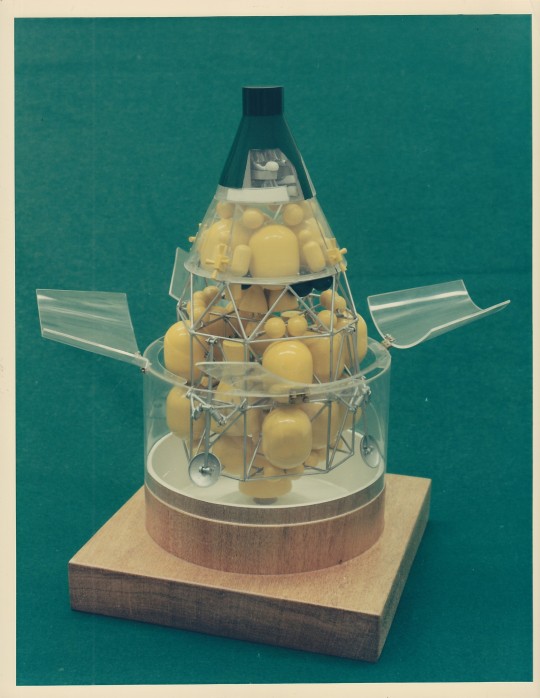
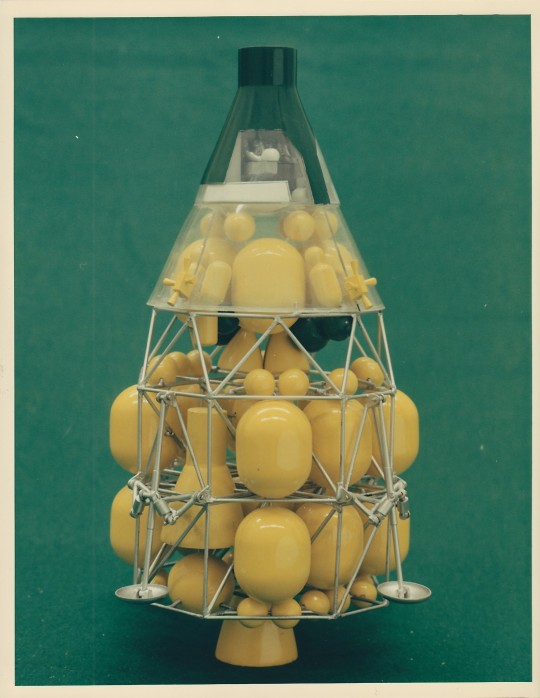
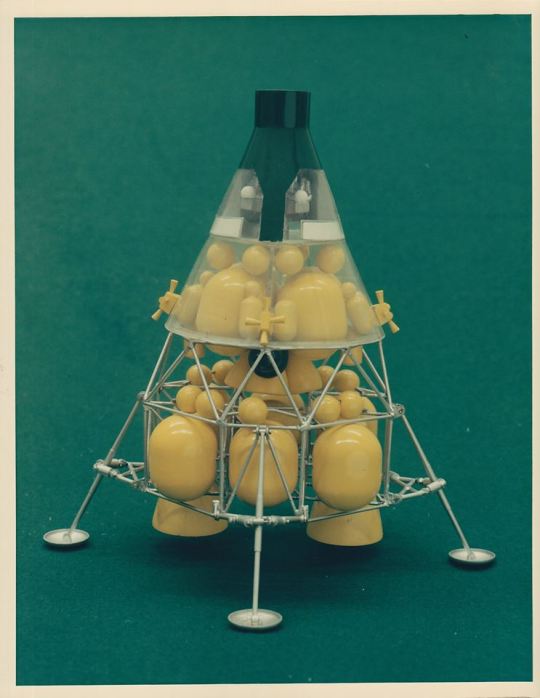
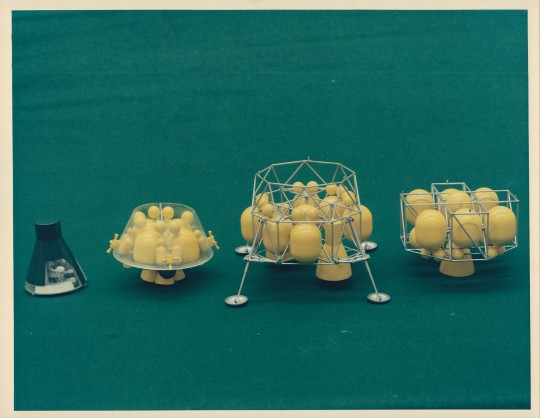
The manned portion was the same as the circumlunar version, a modified earth-orbit Gemini. The aft modules would be retained, but with the retrorockets removed. The retro module space would be used to install Apollo-type lunar distance communications, navigation, and test equipment. Deployable DSIF omni-directional and parabolic antennae would deploy from the aft modules to support lunar-distance communications. To handle re-entry from lunar distances, several modifications were necessary. The capsule's heat shield would be beefed up, and the Rene 41 corrugated shingles of Gemini's skin would be replaced with ablative shingles. The load of attitude control propellant for the capsule's reaction control system was substantially increased. Additional strap-down gyros and solar sensor packages would be added to provide navigation system redundancy. The ejection seats would be deleted and a Mercury-style launch escape tower added. The then-planned Rogallo wing recovery system would be used to glide to the Gemini to a runway landing on US territory after return from the moon. To handle the scientific payload, a camera compartment was added to the nose below the parachute/Rogallo wing housing. The Gemini spacecraft modified in this way had on on-orbit mass of 3955 kg as compared to the 3207 kg of the earth-orbit version.
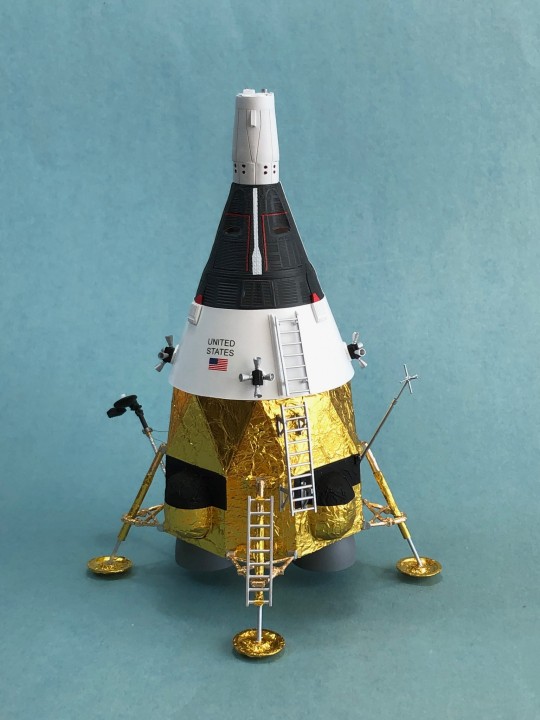
Crew Size: 2. Habitable Volume: 2.55 m3."
-information from Astronautix.com: link
source, source, source
#Gemini Saturn V#Gemini#Gemini Capsule#NASA#Gemini Program#Project Gemini#Saturn V#Rocket#concept art#artwork#cancelled#Lunar Gemini#1964#preliminary design#Cancelled Mission#my post
65 notes
·
View notes
Text
Samsung Watch Active Sensor Array Replacement
Duration: 45 minutes Steps: 7 Steps Get ready to breathe new life into your Samsung Galaxy Watch Active by replacing a malfunctioning or defective sensor array. Follow this clear and easy-to-read step-by-step repair guide from Salvation Repair to get the job done. Step 1 – To start, shut down your Galaxy Watch Active by pressing and holding the bottom button for about 3 seconds – you’ll know…
0 notes
Text

Concept Art by Christian Alzmann. Depicts Cara Dune, Din Djarin, and Grogu returning to Kuiil's Moisture farm on Arvala-7. Image from The Mandalorian, Season 1, Episode 7, The Reckoning.
‘Grogu’s list of needs for the addition to the cabin:
Meditation chamber: quiet, dark-ish, access to snacks, comfy seating, soft music, no loud noises
Sleep chamber: quiet, dark-ish, access to snacks, comfy pillows, soft music, no snoring, access to privy
Work chamber: quiet, bright-ish, access to snacks, storage for tools, supplies, instruction manuals, etc., music, work tables - variable height, access to privy
Play area: Indoor-Outdoor access, access to snacks and beverages, storage for toys and supplies, comfy seating, music, access to snacks for friends, access to privy, rest area integrated into comfy seating area
Intergenerational Meeting Zone: Provision of snacks for all ages and species, beverages for all ages and species, comfy seating with equitable accommodations, music, access to privy(s) - appropriate for all ages and species, storage for tools, materials, games, etc., to be used for stimulating play scenarios appropriate for all ages and species, spill clean up kit(s) - food and beverage related, variable height work surfaces with accessibility kits, items to be determined
Entertainment Zone (not to be confused with play area): suitably sized vid screens for visual entertainments, to include tie ins to existing entertainment portals, recorded media, media generation devices, story telling devices, game playing devices, droid and or mech on board devices; access to snacks and beverages for various ages and species; access to privies for various ages and species; comfy seating, including lounge seating, recliners, rockers, spinners, sliders, and similarly tracked or otherwise mobile seating with independent controls - sometimes known as amusement seating.’
“Grogu, is all this really necessary? For instance, why isn’t the ‘Intergenerational Zone outfitted like the Entertainment Zone and we just consolidate their purposes into one space?”
Din Djarin couldn’t believe he was asking his son that question, even as he heard himself say it out loud. It was ridiculous. Grogu already had a hammock and was more than capable of getting himself up to and on any surface, including all the ones the Mandalorian preferred that he not be able to access.
He sighed.
It was his own fault. Grogu had worked so hard on his lessons and training that Djarin felt it was the least he could do to acknowledge that Grogu’s transition from Jedi youngling to Mandalorian Bounty Hunter wasn’t unappreciated. So he had taken some steps to start the process of adding a workspace onto the cabin that would sized and designed to support Grogu's unique needs.
Knowing that Grogu would want to help him too much, Djarin had come up with the cover story of replacing the sensors on the N-1to just keep him being underfoot the whole time. There were few things Grogu found more boring than testing sensor arrays over and over in order to perform an appropriate level of calibration. The Mandalorian had thought that was pretty clever when he first asked Grogu to give him a hand with ‘the task’. He should have known when Grogu explained that he had some important plans to work on, that his son hadn’t been talking about taking a nap.
Instead, all the time the Mandalorian had spent staking out the new addition, clearing the rocks and brush from the space, and marking where power, water, and other utilities would feed into the space, Grogu had been working on his own detailed planning for an extension to the cabin. That's what that drawing he’d spent so much time was all about. And, it wasn’t lost on the bounty hunter that the basic design was replicating the layout of the Ugnaught Kuiil’s moisture farm on Arvala-7.
Of course the Ugnaught hadn’t named the spaces on the farm and he had certainly made do with a lot of materials scavenged from the surrounding area or bartered for with the local population of Jawas. It was definitely a place that had been thoughtfully pulled together by a person who had the skill, patience, and time to make them suit their needs. Although he regretted not expressing his appreciation for Kuiil’s talents along those lines when they first met, he had noticed the care and effort that had gone into building a space that suited the Ugnaughts needs.
The Mandalorian also appreciated that Grogu wanted a space like that as well. A place where he didn't have to ‘use the Force’ to sit on a seat, or retrieve a snack, or access the privy. Given that Djarin still refused to obtain a pit droid or other mech for duties like that (R5 just refused to enter the cabin), this was the most logical path to follow to encourage Grogu to be more independent and self-reliant. To a point.
“This is the Way.”
The Mandalorian sighed again. His son knew his weaknesses so well and wasn't afraid to leverage them when he really wanted something.
“Okay, but ‘The Meditation’ chamber and ‘The Sleeping’ chamber are practically the same space fitted up the same way. Can we at least combine them?”
Grogu looked at him with those large brown eyes, his face the very definition of serenity.
“May the Force be with you.”
Yup. The Mandalorian was definitely going to need the Force to get through this project. No wonder his people had so much trouble with the Jedi. They were subtle, but effective.
13 notes
·
View notes
Text

X-MOW Anti-Drone Frame. A modification of the Sniper Frame (https://www.deviantart.com/darkeangel/art/XMOW-Sniper-Frame-606695661) for Anti-Drone Warfare.
The Frame’s primary weapon is its powerful communication and sensor array which Ai (the onboard A.I) can use to track, hack and/or jam the drones long before they reach their target.
Secondary weapon is a head mounted laser cannon which can fry the internal electronics of a drone or prematurely detonate any explosive payload.
For close quarters combat the Frame is equipped with two backpack mounted automatic shotguns, each controlled by their own independent AI subroutine. The Frame also carries a third shotgun in its hands. Lastly, an electric net is mounted on the left arm, a device Jess calls “The Bug Zapper”, which is a last resort measure to disable drones.
As a final defensive measure the Frame is outfitted with reactive armor on the shoulders, waist and knees, and the right arm has additional armor bolted on to protect the elbow joint whilst retaining free movement.
The Frame retains its back mounted XION Drive which allows the Unit to float in the air. The original legs of the Sniper Frame have been removed and replaced. Now that the Frame no longer has to supply power to the energy-intensive Beam Sniper-Rifle, the dedicated weapons generator in the chest now feeds power to a secondary XION Drive mounted between the legs. Whilst not strong enough to produce lift, the second Drive continuously feeds X-IONS to two particle storage tanks in the legs, which in turn can power two small but powerful XION thrusters in the feet. Combined with the original XION Drive, this allows the Frame to perform extended jumps up to a height of about a kilometer; thus allowing engagements with Drones operating at higher altitudes.
Typically the X-MOW is optimized for a human pilot with AI assistance; for Anti-Drone operations this is reversed. Ai’s hacking abilities, quicker reaction times and finer control of the machine make her the primary operator. Jess, the pilot, isn’t totally redundant however; her human senses are still more adept at identifying drones, especially ones that employ their own jamming signals or dazzle camouflage, which can confuse the A.I subroutines. Therefore Jess’ primary role becomes Target Acquisition and Identification; she can also still take over control of the Frame should Ai become too overwhelmed with hacking multiple targets.
The AD Frame is an experimental test model and in reality has limited effectiveness. The main issue is that the Frame, which stands 18 meters tall, is too big to adequately defend against sub-meter anti-personnel and reconnaissance drones that are deployed in large numbers on the battlefield. It has more success with the larger, long range drones, but most of the “kills” are a result from hacking and jamming and very few from the mounted weaponry, leaving them mostly superfluous and a drain on power.
The concept is, however, later applied to series of smaller L-MTFs (Light-Mobile Terrestrial Frame) that mount a backpack with a set of four AI controlled sub-arms that can mount various weaponry including shotguns, Bug Zappers and mini guns. These 8-meter tall mechs have a limited production run but enjoy a modicum of success in protecting small squads of infantry and armor against Drone Warfare.
***
A concept I thought up whilst reading about the rapid advances of Drone Warfare in Ukraine. It’s actually kind of low-key terrifying; so this is a way for me to deal with that? IDK. Sorry about the lore dump.
Why yes, I have been watching G-Quuuuuux. Why do you ask?
X-MOW designs are mine. Maybe I’ll post some of my older X-MOW designs some time, if anyone cares to see em.
#original character#original design#mech#mecha#robot#giant robot#digital drawing#digital art#digital illustration#oc art#drone#drone warfare#combat
3 notes
·
View notes
Text

New F-16 Electronic Warfare System ‘on Par with Fifth-Gen’ Enters Flight Test
Sept. 4, 2024 | By John A. Tirpak
The F-16’s new electronic warfare suite, the AN/ALQ-257, has begun flight testing after successfully completing ground tests in an anechoic chamber, Northrop Grumman reported.
The Integrated Viper Electronic Warfare Suite, or IVEWS, mounted in a Block 50 F-16, completed an Air Force evaluation in the Joint Preflight Integration of Munitions and Electronic Sensors (J-Prime) facility—an anechoic chamber—last month, Northrop said. That same aircraft has been conducting flight tests for about two weeks, and will soon be joined by a second F-16, a company official said. Northrop is not yet cleared to reveal the location of testing.
Flight testing to validate what was learned in the chamber will take just a few weeks, and an operational assessment will be completed “by the fourth quarter of this year,” said James Conroy, vice president of navigation, targeting, and survivability, in an interview with Air & Space Forces Magazine. Developmental and operational testing should be completed in early 2025, and based on the results, the Air Force will decide future milestones such as when production and deliveries can begin and when the first F-16 unit is expected to be declared operational, he said.
“We’re going fast,” Conroy said, because the Air Force’s F-16s “don’t have this kind of survivability equipment” and need it to be operationally relevant. The system is an all-digital jammer that has been extensively tested to cooperate with and deconflict with the F-16’s new AN/APG-83 Scalable Agile Beam Radar (SABR), an active electronically-scanned array (AESA) radar. The two systems can be used simultaneously, Conroy said. Both are made by Northrop.
The electronic warfare system is capable of detecting, identifying and countering “the most advanced threats” on the battlefield today, Conroy said, and can perform accurate geo-location of emitters with just a single aircraft. The simulations in the chamber were “intense,” he said.
The IVEWS will be internal to the F-16 and will replace the centerline-mounted AN/ALQ-131 self-defense jamming pod, freeing one external station on the fighter for a fuel tank or weapon. The system will use antennas located elsewhere on the fuselage; the outer mold line of the aircraft hasn’t been altered, Conroy said.
He declined to characterize whether the IVEWS is comparable to the Eagle Passive/Active Warning Survivability System (EPAWSS) being mounted on F-15Es and F-15EXs, saying only that that they are “both advanced electronic warfare systems” and can work together.
The IVEWS is intended to provide the F-16 with electronic warfare capabilities “on a par with fifth-generation aircraft, significantly enhancing survivability for operations in contested and congested electromagnetic spectrum environments,” Northrop said. “Its ultra-wideband suite can detect, identify, and counter advanced radio frequency threats, including millimeter wave systems.”
The IVEWS started out as a Middle-Tier Acquisition program to achieve rapidly fielding; it became an Air Force program of record in 2019.
Conroy said the system will be especially helpful in coping with mobile anti-aircraft radars and missiles whose position is unknown at the start of a mission and which may turn on and fire on F-16s when directly overhead or nearby.
To reach this point, the IVEWS has undergone three years of testing, both on the ground and in the air aboard Northrop’s Bombardier CRJ, acting as a surrogate for the F-16 in the Northern Lightning 2021 exercise, Conroy said. It has also been tested at Hill Air Force Base’s F-16 Block 50 avionics system integration laboratory.
In the chamber, the IVEWS was “subjected to accurate representations of complex radio frequency spectrum threats,” Northrop said in a press release. It demonstrated “the ability to detect, identify, and counter advanced radio frequency threats while operating safely with other F-16 systems.”
Conroy said the system could permit the F-16 to remain credible into the 2040s, and is being evaluated by a number of F-16 user countries, particularly those buying the F-16 Block 70. Turkey has signed a letter of agreement selecting the IVEWS for its Block 70s.
@FHaeromedia via X
16 notes
·
View notes
Text

Plus de résultats de produits similaires chargés
1
F14 TomCat
Enregistrer

Rafale B, Armée de l’Air 341 / 113-FH and, in the background, Rafale C 142 / 113-GU, NATO Tiger Meet 2014 Schleswig-Jagel
Dassault Rafale B, Armée de l’Air (French Air Force) 341 / 113-FH (c/n 4J-17) and Rafale C 142 / 113-GU (c/n 142) in its special “Thundertiger” livery both of Escadron de Chasse 1/7 "Provence at the NATO Tiger Meet 2014, Schleswig-Jagel Air Base (ETNS) Germany. (photo 7170-2). Escadron de Chasse 1/7 "Provence" is based at Saint-Dizier (BA 113). It became a member of the NATO Tiger Association after the Tiger Flight of EC 1/12 (one of the founding members of the NATO Tiger Association) was transferred to EC 1/7 after the disbandment of EC 1/12 ‘Cambrésis’. This squadron operated the Sepecat Jaguar until its replacement by the Rafale in 2005. (source: www.natotigers.org) On the Rafale (Wikipedia): The Dassault Rafale multirole fighter aircraft designed and built by Dassault Aviation. With a high level of agility the Rafale is intended to perform air supremacy, interdiction, reconnaissance, and nuclear strike missions. Many of the aircrafts avionics and features, such as direct voice input, the RBE2 AA active electronically scanned array radar and the Optronique secteur frontal infra-red search and track sensor, were domestically developed and produced for the Rafale programme. Originally scheduled to enter service in 1996, the Rafale suffered significant delays due to post-Cold War budget cuts and changes in priorities. The aircraft is available in three variants: Rafale C single-seat land-based version, Rafale C twin-seat land-based version, and Rafale M single-seat carrier-based version. Introduced in 2001, the Rafale is being produced for both the French Air Force and for carrier-based operations in the French Navy. While the Rafale has been marketed for export to several countries, it has only been selected for purchase by the Indian Air Force. The Rafale has been used in combat over Afghanistan, Libya, Mali and Iraq; features such as the SPECTRA integrated defensive-aids system have been crucial advantages in Libya. Several upgrades to the weapons and avionics of the Rafale are planned to be introduced by 2018.
5 notes
·
View notes
Text

Argo Nauts 1:72 Y-Wing sofubi build update August 7th, 2024
I had posted a scan of this kit's box a few months ago. This is a sofubi (soft vinyl) kit with some brass, pewter, and resin pieces. The main body is vinyl, the disk ventrals at the tail ends of the nacelles are resin, the nacelle beams are brass, and the guns and landing gears are pewter (I think).
This picture above is a quick dry fit of what it looks like so far. I didn't tape the pieces together or anything, but just quickly assembled it for this picture. I later realized that I had hastily attached the nacelles upside-down. I just threw this quickly together to take a photo.
The kit does not come with any decals, so I gave it my own, unique paint scheme. This is a Blue Squadron Y-Wing and I am happy with the stripes I fashioned on my own with masking tape. I painted the vinyl parts with V-Color paints, which are made specifically for painting sofubi kits and toys. This paint is great because when applied properly to vinyl, you cannot scratch it off. It's extremely durable and flexible paint.
I first mixed Light Gray in with Black to make my own German Gray color which I used as an undercoat. I splotched Mr. Masking Neo in areas with a sponge for paint chipping, then went over it with Light Gray. I used Blue and Pastel Blue for the trim, and Orange Yellow to have one panel be a replacement. For the non-sofubi parts, I used Mr. Color 325 (JASDF Gray, IIRC) which is a good match for the V-Color Light Gray. The engine cans were painted a mixture of V-Color Gloss Black and Silver, resulting in a nice gunmetal color.
I later decided to not go with the pastel blue trim for the nacelle tips and re-masked and re-painted them with the matching medium blue I'd used on the cockpit fuselage, which you can see in the photo below. It was a bit tricky, but I also added a small ring of Flesh 1 color on the sensor domes. V-Color has its own clear Smoke color. I made sure to use the Smoke to stain the area around the proton torpedo launchers on the underside. After applying that and a clear gloss top coat, I applied a wash. You cannot use enamel paints on vinyl since they do not react well to each other. Instead I used some Turner Acryl Goache paints, some black with a bit of gray mixed in. Turner paints can be found at any stationery store here in Japan and elementary students use these paints for their classroom art projects. (The jibungous Tsutaya mega bookstore in Maebashi has a great hobby section that has a wide selection of these paints as well as artist oils, pastel chalks, and plenty of other hobby supplies.) I thinned it with Mr. Hobby's Weathering Paint Goache Solvent. (I don't know what "goache" means because I forget... Go look it up if you care.) This is made for making a wash out of acrylic paints. Simple water or acrylic thinner can cause the paint to dry in splotches, but this solvent is made to help the paint run into contours and stay still instead of spreading into splotches.

There is no flat clear V-Color paint, so I had to create my own with Clear and Flat Base and tested it out on some spare vinyl until it looked right. I think maybe it might be a bit too flat, but I'm alright. After this flat coat, the blue looks considerably subdued and blends in better with the light gray.
The photo above is just another sloppy dry fit. Thus, it doesn't look straight. So far I have only glued the nose cannons to the cockpit pod, the sensor array domes to the nacelle tips, the engine cans and the exhaust shrouds that cover them to the engine pods, and I have glued the disk vectrals to the support pylons at the ends of the nacelles. I have yet to secure these beams to the engine pods, which are also not glued to the engine pylons. Nor have I glued the fuselage, cockpit, canopy, and such.

To quote Han Solo, "Here's where the fun begins." While this kit provides brass rods for the support pylons, you have to provide your own wires for the piping and bend them all into shape. If I don't get this part right, the model won't look good. So, I am a bit nervous. I am using Wave's C-Line brass rods. Since I have seen some Y-Wing builds in which the pipes were painted a metallic color, I think I might just leave mine unpainted. A viewer on YouTube suggested to me to paint the wires a metallic color for scale, but I think it looks fine as it is. What do you think? They look a bit too shiny since the fluorescent light is shining directly onto them in this picture. I will apply a wash on the brass rods and I was thinking that I will hand-brush Mr. Metal Primer since it is clear and the enamel or whatever should stick to it better after that. Maybe I'll use that Games Workshop Nuln Oil as a wash over the pipes. The pipes should add the bonus value of acting like pins to keep the pieces together.

So far, my only complaint is the cockpit canopy. It was difficult to cut out the windows and I think it really should have been molded in resin. The Astromech was painted V-Color Gloss Black and masked off. I will paint its trim with Mr. Hobby Aqueous Gloss White. I also need to paint the cockpit instrumentation with various colors too.
I'm really enjoying this build and as a result I'm getting back into the three Nadia sofubi kits by Tsukuda that have been languishing for years as shelf queens. I've made good progress with those and I will post an update on those soon. I've also begun working on a Deedlit sofubi kit by Kaiyodo.
11 notes
·
View notes
Text
had a talk about robotgirls, decided to try my hand at a short story
You're hanging off the ceiling while your girlfriend is working on you. Everything looks a bit hazy in the dimly lit room. She's laying right underneath you, taking off your cover plates to inspect the damage. — Yeah, that EMP got you good. I'm glad the static shielding worked, 'cause otherwise you'd be cooked crisp. Try to avoid corporate strike groups during your next runs, okay? — I know, i know, but i couldn't just let them take that guy away for disassembling, you know? — Alright, supergirl. Just know that you're paying out of your pocket for this heroism, 'kay? You don't want to admit it, but she is right — the burned components have to be replaced, and flashed android parts aren't cheap. She puts away the last cover plate and pushes her hands inside, skillfully disconnecting all the components in the way. You can feel every component disappear as the internal log gets filled with warnings. — Alright, let's see… two servos and a backup controller in the left leg, some spare neural processing units… ooh, they got one of the drives in your long term memory RAID array. And even some dies on your RAM sticks. Whatever it was, it was aimed to get your brains. She plugs off a couple more things, and then sends you a message through the LAN Alright, turn off all unnecessary systems, i'll ping you once i'm done here You do as instructed and turn off most sensors, all servos, video and audio peripherals, as well as the aforementioned RAID array, relying on the instructions saved to the boot drive. It seems dark. All you can feel is some things being disconnected from you. You reach to the boot drive for instructions, and it returns a string "prepare for shutdown RAM devices 3, 4, 5 and 7. set listener to port 8080. reconnect all systems on listener event" You interpret it and perform the instructions, freeing up those sticks and send a command to reindex the remaining memory… you check the internal clock, the reindexing and reboot of the personality network took about 3.2 seconds, not bad. It's kind of hard to hold onto any thoughts, but it doesn't matter. You set a listener for the ping to the port from the instructions, and await… Some 15 minutes later the listener returned true, and you went down again to perform the necessary instructions… you check the internal clock and the log, the soft reboot took 3.5 seconds, and judging by the logs the new RAM worked as expected. You reconnect the RAID array, scan all ports and reconnect all the servos, processing cores, etcetc… The room is still dimly lit and nearly silent, the most prominent sound being your fans spinning at full blast. You check the temperature readings just in case, and see that they're within the acceptable range. — I'm back on. How did it go? — Swimmingly. What's the status. — All systems online and in optimal condition. It'll take a bit for the RAID array to work it's magic but other than that i feel great! So, will i have enough pocket money? — No and for a while. We're gonna need to restock quite a few things, and that means dipping into the savings. If i were you I'd pray that the guy you saved is generous, and will pay off some of the spares, otherwise I'm gonna need to find us couple more gigs to fix this dent in our budget.
#196#r/196#r/197#robot girl#it's intentionally unfinished. i thought about two endings but couldn't bother writing any of them
10 notes
·
View notes
Text
Why are headlights so expensive for cars?
The high cost of modern car headlights is driven by a convergence of advanced technology, complex design, stringent regulations, and market factors. Here's a breakdown of the key reasons:
Advanced Technology & Complexity:
LED/Laser/Matrix Systems: Modern headlights use multi-element LED arrays, adaptive projectors, laser elements (on high-end models), or matrix/pixel technology that individually dims segments of the beam. This requires sophisticated control units, sensors, and wiring.
Adaptive Functionality: Features like auto-leveling, cornering beams, glare-free high beams, and dynamic light projections require motors, cameras, complex software, and extra wiring harnesses.
Integrated Components: Headlights now house DRLs (Daytime Running Lights), turn signals, position lights, and often front-facing sensors (radar/camera for ADAS) all in one sealed unit, driving up complexity.
Precision Engineering & Materials:
Optical Precision: Lenses and reflectors are molded with extreme precision to meet strict beam pattern regulations and avoid glare. Molds for these optics are incredibly expensive to design and manufacture.
Materials: High-performance polycarbonate lenses resist yellowing and cracking, while complex aluminum or magnesium heat sinks efficiently dissipate heat from powerful LEDs/Lasers. Seals must be perfect to prevent moisture and corrosion. Internal reflectors use specialized coatings.
Durability Requirements: Headlights must withstand extreme temperatures, UV radiation, road debris impacts, vibrations, and chemical exposure (car washes, road salt) for the vehicle's lifespan. This requires high-grade materials and construction.
Regulation & Testing Overhead:
Global Standards: Headlights must comply with strict global regulations (SAE, ECE, etc.) regarding beam pattern, intensity, cutoff sharpness, and aiming. Developing, testing, and certifying each headlight design for different markets adds significant cost.
Complex Testing: Extensive lab and road testing is required to ensure compliance, durability, and performance in all conditions, adding R&D costs.
Design and Manufacturing Integration:
Styling Demands: Headlights are critical styling elements. Aggressive shapes, intricate lighting signatures ("light jewelry"), and seamless integration with body panels require complex, unique housings for each model.
Custom Manufacturing: Headlights are model-specific (often even trim-level specific). Low-volume production runs compared to simple bulbs mean costs aren't spread over millions of identical units. Assembly involves delicate electronics and precise calibration.
Module Design: Modern headlights are typically sold as sealed assemblies ("modules"). If anything fails inside (LED chip, driver, ballast, motor, wiring), you often have to replace the entire 800+ unit, not a 10 bulb.
Supply Chain & Market Factors:
OEM vs. Aftermarket: Dealers charge high prices for genuine OEM parts, covering their overhead and profit margins. While quality aftermarket options exist (often significantly cheaper), OE parts command a premium.
Insurance Influence: Since insurance often pays for replacements after collisions (which frequently damage headlights), manufacturers have less pressure to minimize headlight costs compared to components owners pay for directly.
Low Price Elasticity: Headlights are essential safety items. Consumers need them to drive legally and safely, reducing the incentive for manufacturers/dealers to compete heavily on price for replacements.
Supplier Profit: Tier-1 suppliers (like Valeo, Bosch, Magna, Koito) design and build these complex units and need to recoup their substantial R&D and tooling investments per unit sold to the automaker.
Labor Cost (Hidden): Installation is often complex, requiring bumper/fender removal and sometimes electronic calibration/reprogramming. While the part cost is high, labor adds significantly to the total replacement expense perceived by the owner.
Comparison to Older Designs:
Simple Halogen Reflectors: Used cheap bulbs (10-50), simple reflectors, and a basic lens. Easy to manufacture replaceable bulbs. Entire assembly replacement was relatively inexpensive (100-300).
HID Projectors: Introduced cost via ballasts and specialized bulbs (50-150 per bulb), but the projectors and housings were less complex than modern LED units. Assemblies cost more than halogens but less than LEDs.
Modern LED/Adaptive Units: Represent a quantum leap in technology, integration, and complexity, hence the price jump.
In essence: You're paying for high-tech electronics, extreme precision optics, complex software integration, advanced materials built for durability, significant R&D/testing/regulatory costs, custom low-volume manufacturing of a styling-critical safety component, and market dynamics where insurers often foot the bill. It's a far cry from swapping out a simple bulb in a basic reflector housing.

#led lights#car lights#led car light#youtube#led auto light#led headlights#led light#led headlight bulbs#ledlighting#young artist#led light bulbs#led strip lights#car rental#electric cars#classic cars#car#cars#truck#porsche#suv#lamborghini#sabrina carpenter#bmw#carlos sainz#autonomous vehicle headlights#overtake another vehicle#older vehicles#vehicle#auto mode#automobiles
3 notes
·
View notes